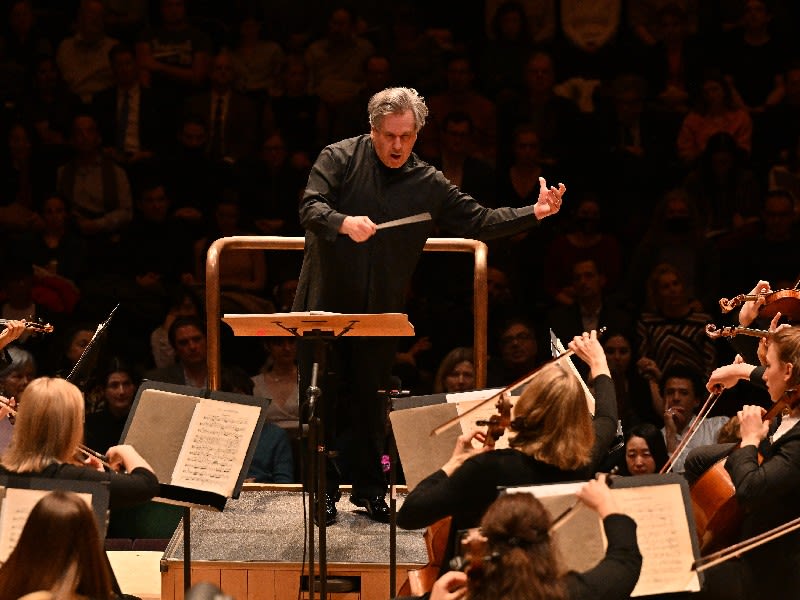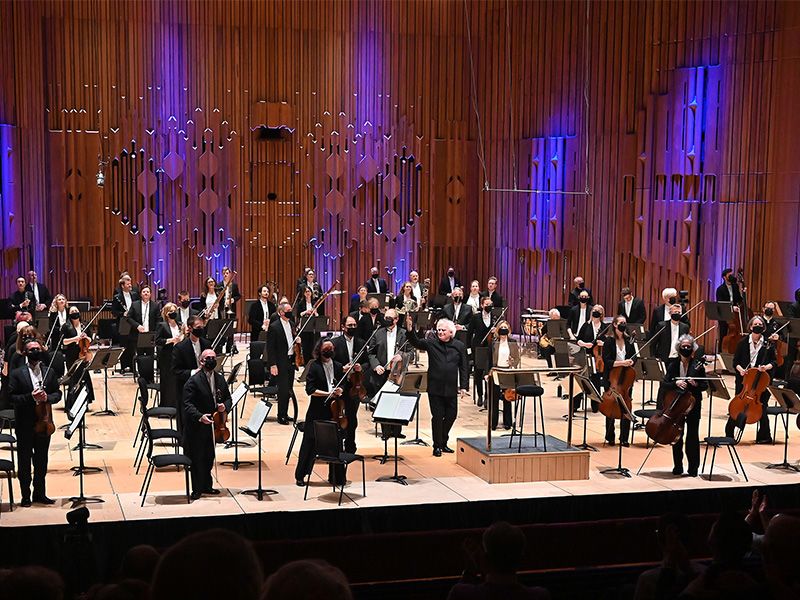LSO Half Six Fix
Beethoven 7
Digital Concert Guide

THE CONCERT
Wednesday 11 October 6.30pm
Ludwig van Beethoven Symphony No 7
Sir Antonio Pappano conductor & presenter
London Symphony Orchestra
USING YOUR DIGITAL CONCERT GUIDE
- Navigate using the menu icon (≡) at the top of the screen.
If you're using this guide while enjoying the concert:
- Connect to the Barbican Free WiFi network in the Concert Hall.
- Please set your phone to silent and don't use other apps during the music.
Welcome to tonight's Half Six Fix, a different way to experience the London Symphony Orchestra.
In tonight's concert, experience Beethoven at his most rhythmic in his Symphony No 7, famously described as the 'apotheosis of dance'.
Ludwig van Beethoven
Symphony No 7
✒️ 1811–12 | ⏰ 37 minutes

Often a piece of music will seem to run completely at odds with the composer’s circumstances at the time it was written: Ralph Vaughan Williams’ Fifth Symphony (which you can hear in another Half Six Fix concert on 17 April) appeared at the height of World War II in 1943, but it surprised listeners with its serene mood. By contrast, Ludwig van Beethoven’s exuberant Seventh Symphony seems directly to reflect the rejuvenation he felt during a period of recuperation in the Bohemian spa town of Teplitz in 1811, at the time he began writing the Symphony.
Rhythmic drive was not new for Beethoven – you only need to think of the famous four-note opening of the Fifth Symphony (da-da-da DAH!) – but in the Seventh he took rhythm’s propulsive force to a new level. Each of the four movements is possessed by emphatic repetition of tight rhythmic motifs. The composer Carl Maria von Weber, after hearing the Seventh, is said to have declared Beethoven ‘ripe for the madhouse’, and Richard Wagner – who famously described the work as ‘the apotheosis of Dance’ – noted how ‘melody and harmony unite around the sturdy bones of rhythm’.
Such a Romantic
From the ‘wrong-key’ opening of his Symphony No 1 to the groundbreaking addition of a choir to bring home a message of peace and unity at the end of the Symphony No 9, Beethoven remains one of the most radical of all symphonists.
The Seventh is a study in rhythmic drive. That said, according to the musicologist Maynard Solomon, it is also ‘the most romantic of the nine … it is full of swift unexpected changes and contrasts, exciting the imagination in the highest degrees, and whirling it suddenly into new and strange regions’.
The first movement opens with a slow introduction that is timeless and elemental, similar in mood to ‘The Representation of Chaos’ that opens Joseph Haydn’s oratorio The Creation. Even here there’s a hint of the prominent role rhythm will play in the Symphony – the steady, regular pattern of the rising scales and the repetitions on a single note. Then there’s a heart-stopping Morse code-like exchange, with violins answering flute and oboe, before the movement proper, which is marked Vivace (lively). The whole of the movement is then dominated by a three-note bouncing figure, like an obsessive mantra.
The Lock Shock
In 2019 ‘a substantial lock’ of Beethoven’s hair went up for sale at Sotheby’s in London. The snipping was apparently made by Beethoven himself and personally given to his friend Anton Halm in 1826.
The item fetched £35,000 – double the estimated selling price – and went to an anonymous bidder. By comparison a lock of Admiral Lord Nelson’s hair was sold three years earlier for only £13,750 (you could say a snip at half the price).
The second movement would normally be the slow movement in a typical Classical symphony, but here it’s only a slower movement. This time the obsessive rhythm is a long–short–short figure. It tries to establish itself as a tune, to flourish into something new, but instead it grows through repetition. When a ‘real’ tune finally arrives (to be heard in the clarinet and bassoon), the drip-drip rhythm carries right on.
Fit For a King
The slow movement of the Seventh Symphony was used in the 2010 film The King’s Speech. At the climactic moment when George VI (Colin Firth) addresses the nation following the declaration of war with Germany, his speech therapist Lionel Logue (Geoffrey Rush) begins quietly conducting, to help overcome the king’s stammer. As the music grows in assurance through the repeated phrases, so the monarch becomes more fluent and uninhibited.
The breathless Presto movement practically falls over itself with its speed and pin-sharp precision. Here the regular pattern of three equal (but fast!) beats is joined by its two main variants, long–short and short–long, often with comic effect. It was perhaps the resulting effect to which conductor Thomas Beecham was referring when he quipped that this movement sounded like ‘a lot of yaks jumping about’. Along the way, Beethoven injects disruptive touches – an interjection here, an extra beat there. The contrasting section is more majestic but even this is shot through with a new, clipped rhythm, later adopted as a cheeky drone in the horns. The rustic tone gains fuller expression in the stamping finale, rugged and joyous. The rhythmic drive is now inexorable and the conclusion to the symphony could hardly be rammed home more affirmatively.
The Symphonic Scoreboard
Beethoven completed nine symphonies and began a tenth before his death in 1827. Here’s how that tally compares with other composers:
Joseph Haydn – 104
Wolfgang Amadeus Mozart – 41
Franz Schubert – 8, plus the ‘Unfinished’
Gustav Mahler – 9, plus an unfinished Tenth
Pyotr Ilyich Tchaikovsky – 6, plus the Manfred symphony
Jean Sibelius – 7
Dmitri Shostakovich – 15
The Finnish composer and conductor Leif Segerstam (born 1944) has beaten them all – notching up more than 350 symphonies since 1977.
Ludwig van Beethoven
composer

In his early twenties Beethoven left his native Bonn for Vienna, where he became established as a composer, piano virtuoso and improviser of great ability. Largely following the Classical models of Haydn and Wolfgang Amadeus Mozart in his ‘early’ period, he recognised signs of his impending deafness as early as 1796. In 1802 he revealed his suffering and alienation, his thoughts of suicide and his creative resolve in his Heiligenstadt Testament. His ‘middle’ period was characterised by a broadening of form and an extension of harmony to suit his proto-Romantic expression, spawning the Symphonies Nos 2 to 8, notable piano sonatas, several string quartets and his only opera, Fidelio. He produced less music in his ‘late’ period (from 1813) but his last years saw his mould-breaking ‘Choral’ Symphony No 9 and an exploration of increasing profundity in the more intimate mediums of the string quartet and piano sonata.

Skull and Judgement
In July American businessman Paul Kaufmann donated several bone fragments from Beethoven’s skull to the Medical University of Austria for study. He had found them in a safety deposit box in a French bank after his mother’s death. She in turn received them from her great-uncle Franz Romeo Seligmann, who had been involved with the reburial of Beethoven’s body in 1863. The university will study the bones to gain a better insight into Beethoven’s health.
The Performers

Sir Antonio Pappano
conductor
One of today’s most sought-after conductors, acclaimed for his charismatic leadership and inspirational performances in both symphonic and operatic repertoire, Sir Antonio Pappano has been Music Director of the Royal Opera House Covent Garden since 2002. This season he becomes LSO Chief Conductor Designate, becoming Chief Conductor from the 2024/2025 season. Nurtured as a pianist, repetiteur and assistant conductor at many of the most important opera houses of Europe and North America, including at the Lyric Opera of Chicago and several seasons at the Bayreuth Festival as musical assistant to Daniel Barenboim, Pappano was appointed Music Director of Oslo’s Den Norske Opera in 1990, and from 1992 to 2002 served as Music Director of the Théâtre Royal de la Monnaie in Brussels. In 2023, he stepped down as Music Director of the Orchestra dell’Accademia Nazionale di Santa Cecilia in Rome, having held the post since 2005.
London Symphony Orchestra
At the London Symphony Orchestra we strive to inspire hearts and minds through world-leading music-making. We were established in 1904, as one of the first orchestras shaped by its musicians.
Through inspiring music, a world-leading learning and community programme and technological innovations, our reach extends far beyond the concert hall.
On Stage
Leader
Andrej Power
First Violins
Cellerina Park
Clare Duckworth
Ginette Decuyper
Maxine Kwok
William Melvin
Stefano Mengoli
Claire Parfitt
Elizabeth Pigram
Laurent Quénelle
Harriet Rayfield
Sylvain Vasseur
Morane Cohen-Lamberger
Second Violins
Julián Gil Rodríguez
Thomas Norris
Sarah Quinn
Miya Väisänen
David Ballesteros
Matthew Gardner
Alix Lagasse
Belinda McFarlane
Iwona Muszynska
Csilla Pogány
Andrew Pollock
Paul Robson
Violas
Eivind Ringstad
Gillianne Haddow
Malcolm Johnston
Steve Doman
Thomas Beer
Sofia Silva Sousa
Robert Turner
Mizuho Ueyama
Anna Dorothea Vogel
Annie-May Page
Cellos
Rebecca Gilliver
Anna Garde
Alastair Blayden
Ève-Marie Caravassilis
Daniel Gardner
Laure Le Dantec
Amanda Truelove
Ghislaine McMullin
Double Basses
Rodrigo Moro Martín
Patrick Laurence
Matthew Gibson
Joe Melvin
Jani Pensola
Chaemun Im
Flutes
Gareth Davies
Brontë Hudnott
Oboes
Philibert Perrine
Rosie Jenkins
Clarinets
Matthew Glendening
Chi-Yu Mo
Bassoons
Daniel Jemison
Joost Bosdijk
Horns
Timothy Jones
Angela Barnes
Daniel Curzon
Jonathan Maloney
Trumpets
James Fountain
Gareth Small
Robin Totterdell
Timpani
Nigel Thomas



